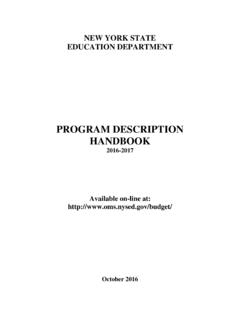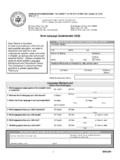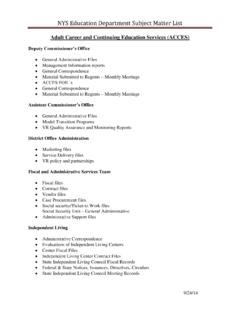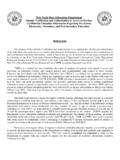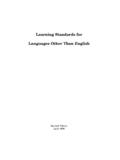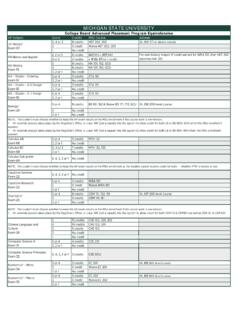Transcription of NYS Math Standards Grade 6 Crosswalk - New York State ...
1 NYSED Grade 6 Draft New York State next generation mathematics learning Standards Grade 6 Crosswalk Ratio and Proportional Reasoning Cluster NYS P-12 CCLS NYS next generation learning Standard Understand ratio concepts and use ratio reasoning to solve problems. Understand the concept of a ratio and use ratio language to describe a ratio relationship between two quantities. For example, The ratio of wings to beaks in the bird house at the zoo was 2:1, because for every 2 wings there was 1 beak. For every vote candidate A received, candidate C received nearly three votes. Understand the concept of a ratio and use ratio language to describe a ratio relationship between two quantities. , The ratio of wings to beaks in the bird house at the zoo was 2:1, because for every 2 wings there was 1 beak.
2 For every vote candidate A received, candidate C received three votes. Understand the concept of a unit rate a/b associated with a ratio a:b with b 0, and use rate language in the context of a ratio relationship. For example, This recipe has a ratio of 3 cups of flour to 4 cups of sugar, so there is 3/4 cup of flour for each cup of sugar. We paid $75 for 15 hamburgers, which is a rate of $5 per hamburger. Note: Expectations for unit rates in this Grade are limited to non-complex fractions. Understand the concept of a unit rate a/b associated with a ratio a:b with b 0 (b not equal to zero), and use rate language in the context of a ratio relationship. , This recipe has a ratio of 3 cups of flour to 4 cups of sugar, so there are cup of flour for each cup of sugar. "We paid $75 for 15 hamburgers, which is a rate of $5 per hamburger.
3 " Note: Expectations for unit rates in this Grade are limited to non-complex fractions. Use ratio and rate reasoning to solve real-world and mathematical problems, , by reasoning about tables of equivalent ratios, tape diagrams, double number line diagrams, or equations. Use ratio and rate reasoning to solve real-world and mathematical problems. Note: Strategies may include but are not limited to the following: tables of equivalent ratios, tape diagrams, double number lines, and equations. NYSED Grade 6 Draft New York State next generation mathematics learning Standards Grade 6 Crosswalk Ratio and Proportional Reasoning Cluster NYS P-12 CCLS NYS next generation learning Standard Understand ratio concepts and use ratio reasoning to solve problems. Make tables of equivalent ratios relating quantities with whole-number measurements, find missing values in the tables, and plot the pairs of values on the coordinate plane.
4 Use tables to compare ratios. Make tables of equivalent ratios relating quantities with whole-number measurements, find missing values in the tables, and plot the pairs of values on the coordinate plane. Use tables to compare ratios. Solve unit rate problems including those involving unit pricing and constant speed. For example, if it took 7 hours to mow 4 lawns, then at that rate, how many lawns could be mowed in 35 hours? At what rate were lawns being mowed? Solve unit rate problems. , If it took 7 hours to mow 4 lawns, then at that rate, how many lawns could be mowed in 35 hours? At what rate were lawns being mowed? What is the unit rate? Note: Problems may include unit pricing and constant speed. Find a percent of a quantity as a rate per 100 ( , 30% of a quantity means 30/100 times the quantity); solve problems involving finding the whole, given a part and the percent.
5 Find a percent of a quantity as a rate per 100. Solve problems that involve finding the whole given a part and the percent, and finding a part of a whole given the percent. , 30% of a quantity means 30100 times the quantity. Use ratio reasoning to convert measurement units; manipulate and transform units appropriately when multiplying or dividing quantities. Use ratio reasoning to convert measurement units; manipulate and transform units appropriately when multiplying or dividing quantities. Note: Conversion of units occur within a given measurement system, not across different measurement systems. NYSED Grade 6 Draft New York State next generation mathematics learning Standards Grade 6 Crosswalk The Number System Cluster NYS P-12 CCLS NYS next generation learning Standard Apply and extend previous understandings of multiplication and division to divide fractions by fractions.
6 Interpret and compute quotients of fractions, and solve word problems involving division of fractions by fractions, , by using visual fraction models and equations to represent the problem. For example, create a story context for (2/3) (3/4) and use a visual fraction model to show the quotient; use the relationship between multiplication and division to explain that (2/3) (3/4) = 8/9 because 3/4 of 8/9 is 2/3. (In general, (a/b) (c/d) = ad/bc.) How much chocolate will each person get if 3 people share 1/2 lb of chocolate equally? How many 3/4-cup servings are in 2/3 of a cup of yogurt? How wide is a rectangular strip of land with length 3/4 mi and area 1/2 square mi? Interpret and compute quotients of fractions, and solve word problems involving division of fractions by fractions. Note: Strategies may include but are not limited to the following: using visual fraction models, a standard algorithm, and equations to represent the problem.
7 , Create a story context for (23) (34) and use a visual fraction model to show the quotient; use the relationship between multiplication and division to explain that (23) (34) = 89 because 34 of 8 9 is 23. In general, ( ) ( ) = . , How much chocolate will each person get if 3 people share 12 lb of chocolate equally? How many 34 cup servings are in 23 of a cup of yogurt? How wide is a rectangular strip of land with length 34 mi and area 12 square mi? Compute fluently with multi-digit numbers and find common factors and multiples. Fluently divide multi-digit numbers using the standard algorithm. Fluently divide multi-digit numbers using a standard algorithm. Fluently add, subtract, multiply, and divide multi-digit decimals using the standard algorithm for each operation. Fluently add, subtract, multiply, and divide multi-digit decimals using a standard algorithm for each operation.
8 NYSED Grade 6 Draft New York State next generation mathematics learning Standards Grade 6 Crosswalk The Number System Cluster NYS P-12 CCLS NYS next generation learning Standard Compute fluently with multi-digit numbers and find common factors and multiples. Find the greatest common factor of two whole numbers less than or equal to 100 and the least common multiple of two whole numbers less than or equal to 12. Use the distributive property to express a sum of two whole numbers 1 100 with a common factor as a multiple of a sum of two whole numbers with no common factor. For example, express 36 + 8 as 4 (9 + 2). Find the greatest common factor of two whole numbers less than or equal to 100. Use the distributive property to express a sum of two whole numbers 1 100 with a common factor as a multiple of a sum of two whole numbers with no common factor other than 1.
9 Find the least common multiple of two whole numbers less than or equal to 12. , Express 36 + 8 as 4 (9 + 2). Apply and extend previous understandings of numbers to the system of rational numbers. Understand that positive and negative numbers are used together to describe quantities having opposite directions or values ( , temperature above/below zero, elevation above/below sea level, credits/debits, positive/negative electric charge); use positive and negative numbers to represent quantities in real-world contexts, explaining the meaning of 0 in each situation. Understand that positive and negative numbers are used together to describe quantities having opposite directions or values. Use positive and negative numbers to represent quantities in real-world contexts, explaining the meaning of 0 in each situation.
10 , temperature above/below zero, elevation above/below sea level, debits/credits, positive/negative electric charge. Understand a rational number as a point on the number line. Extend number line diagrams and coordinate axes familiar from previous grades to represent points on the line and in the plane with negative number coordinates. Understand a rational number as a point on the number line. Use number lines and coordinate axes to represent points on a number line and in the coordinate plane with negative number coordinates. NYSED Grade 6 Draft New York State next generation mathematics learning Standards Grade 6 Crosswalk The Number System Cluster NYS P-12 CCLS NYS next generation learning Standard Apply and extend previous understandings of numbers to the system of rational numbers. Recognize opposite signs of numbers as indicating locations on opposite sides of 0 on the number line; recognize that the opposite of the opposite of a number is the number itself, , ( 3) = 3, and that 0 is its own opposite.
